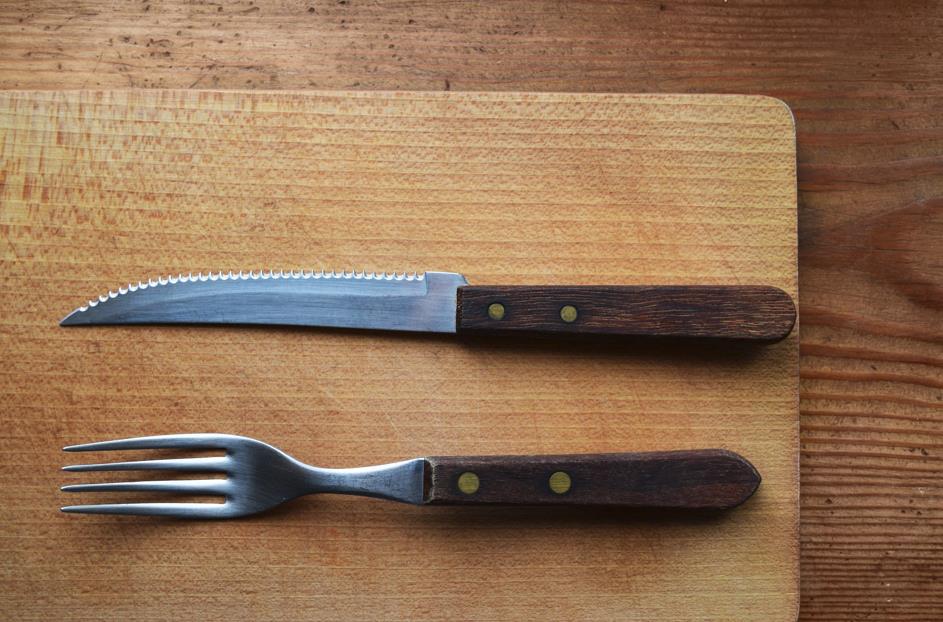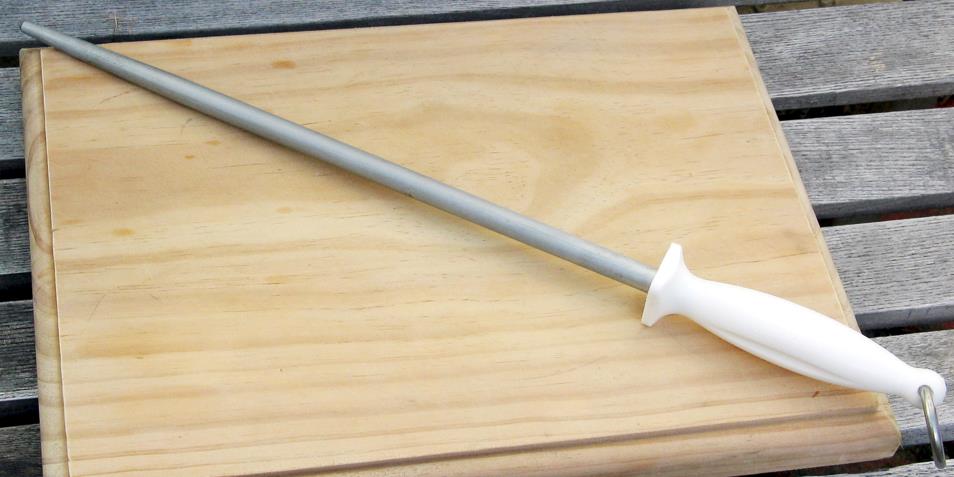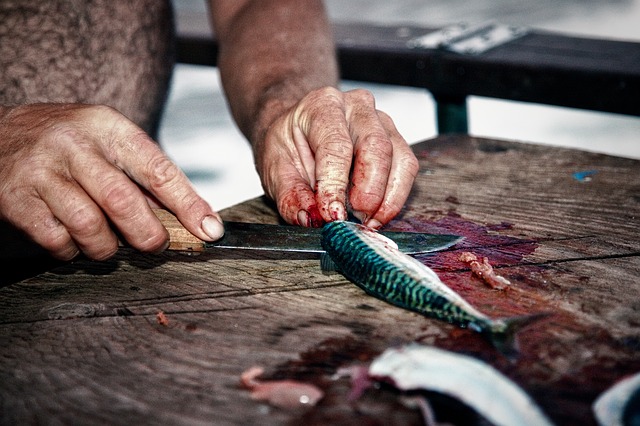If you are an avid meat eater or like to enjoy a steak now and then, a steak knife is a useful tool to have in your kitchen. The humble steak knife is not much bigger than a butter knife but is very practical for serving small pieces of meat, like steaks and ribs. The two main steak knives on the market are the serrated and non-serrated varieties.
Serrated steak knives have jagged edges with a series of sharp teeth, separated by grooves. This design saws through tough layers of meat well because the sharp teeth create many small tears to reduce friction. This means you can slice meat without pushing too hard. The serrated design holds its edge for longer, though is more difficult to sharpen.
Non-serrated steak knives have the same blade shape, but a smooth edge. This cannot tear meat as easily, so you must press down harder to cut. If you keep the blade sharp, it will make clean and aesthetic slices. This type of knife is better for rare and soft cuts of meat. Smooth blades tend to blunt faster, however, the sharpening process is more straightforward.
So, which is better? The answer depends on which meats you like, how well you cook them, and how you wish to present them. Some cooks and steak lovers would benefit from having both types in their arsenal. In the upcoming sections, we will highlight the strengths and weaknesses of each so you can better decide for yourself.
Table of contents
Why do you need a good steak knife?

The truth is that some people do not need a steak knife, let alone a very good one. To enjoy the superior performance of a top-quality steak knife, you will typically have to spend more money. Buying a steak knife is not necessary for people who only occasionally prepare steaks and other cuts of meat.
Yet, for those who adore the rich taste of meat and like nothing more than cutting into a juicy steak, a steak knife is an important tool. Some cooks only need a simple chef knife for most of their kitchen tasks. Steak enthusiasts, however, need dedicated knives to prepare their delicious pieces of meat.
A good steak knife is important for a few simple reasons: it will last longer, require less maintenance, and be less likely to crack. Steak knives are often made from stainless steel that remain firm while slicing through tough cuts of beef and pork. Yet, they must also be expertly crafted to cut meat cleanly with little effort.
Steak lovers care not only about the meat’s taste but also its presentation. A steak knife is a specialized tool that makes beautiful, delicate, and even slices as no other knife can. To fully enjoy the delights of a steak, you need to prepare it properly.
What is a serrated steak knife?

Appearance
A steak knife is a short and sharp kitchen knife with a relatively slender blade. The blade consists of a mostly flat spine that curves slightly upwards at the tip. The edge of the blade starts flat near the handle but curves more obviously near to the tip.
A serrated steak knife does not have a smooth edge, rather it features a series of small teeth that stick out on the knife’s edge. These teeth are arranged in regular intervals. The serrated pattern is similar to that of a wood saw.
How to use it
When cutting a steak with a serrated knife, the first step is to secure the piece of meat on your plate or cutting board. You can do this with a fork. This is especially important if you are preparing a tough cut of meat or a steak that is more well-cooked.
Next, while gripping the handle firmly with your dominant hand, you must place the knife’s edge on top of the steak. Decide where you would like to slice and press down ― start a gradual back-and-forth motion to tear the surface of the meat with the blade’s teeth.
As you break into the lower layers of flesh, start applying more pressure to the knife’s handle. Continue moving the knife forward and backward until you have cut off a clean piece of meat. Repeat the process to cut the rest of the steak into pieces.
Pros of a serrated steak knife
- The serrated edge is effective in the same way as a serrated bread knife. The teeth provide multiple points of high pressure to pierce through the surface of a steak. This is particularly useful when working with tough cuts of meat.
- You do not have to push down hard on a serrated knife for it to pierce the surface of your steak. This means it will cut through without squashing/deforming the meat. Therefore, the steak will retain more of its delicious juices and be tastier as a result.
- A serrated knife generally retains its edge for longer. That is because less of the blade’s edge ever touches hard wooden or ceramic plates (only the teeth). Overall, serrated steak knives require little maintenance if you use them occasionally.
Cons of a serrated steak knife
- While serrated blades need less frequent sharpening, their sharpening process is more complicated. Each of the grooves on the serrated blade needs to be sharpened individually. It is more challenging to retain the blade angle on a serrated edge, so you may need help from an expert.
- Cleaning a serrated steak knife is also a bit more challenging. Food particles are more likely to stick to the pointed teeth of the blade. It is also difficult to clean the narrow gaps between the teeth with a sponge.
- In a way, a serrated knife is more dangerous than a straight-edged version. The teeth of the blade are so fine and sharp that they could accidentally catch on your skin and cause you to bleed.
What is a non-serrated steak knife?

Appearance
A non-serrated steak knife has the same shape as its serrated equivalent. It is a short kitchen knife with a slim and curved blade. The edge is completely smooth (though, very sharp!) like on a standard chef knife.
How to use it
The lack of teeth on a non-serrated steak knife means that it does not tear flesh as easily. So, you must cut with more force. Straight-edged blades are better at slicing softer pieces of meat and those that are rarer (not so well-cooked).
As with the serrated steak knife, you must secure the meat by stabbing it with a fork before cutting. Decide where you would like to cut your steak. Then, while gripping the handle firmly, press the blade edge into the surface
Press down firmly and work the knife back and forth to tear through all layers of the meat and separate a piece. Continue cutting the steak into pieces until you are satisfied.
Pros of a non-serrated steak knife
- A non-serrated steak knife cuts very delicately. Because of its design, it makes a single smooth cut into a steak, rather than creating many small tears. This produces clean cuts of softer meats.
- You do not need to learn any special techniques to care for your non-serrated knife. The sharpening and cleaning processes are virtually identical to those of a chef knife.
- A non-serrated knife is more versatile. When you aren’t using it to cut steaks, your smooth steak knife can act as a simple boning or paring knife too.
Cons of a non-serrated steak knife
- Since non-serrated steak knives are not as effective at tearing through meat, you have to push the blade down harder (unless the edge is very sharp). Doing this can squash the meat and cause juices to exit. This can make the meat dry and less succulent.
- A non-serrated blade provides a smooth slicing motion but will wear down more quickly. The entire length of the blade is exposed to hard cutting surfaces, so will require more regular sharpening.
Serrated vs non-serrated steak knife: a comparison
| Serrated | Non-serrated | |
| Blade & edge | A slim and curved blade with a series of small sharp teeth, separated by regular grooves. | A slim and curved blade with a smooth yet razor-sharp edge. |
| Performance | The teeth of a serrated blade are effective at reducing friction by making multiple tears. The teeth create many points of high pressure to cut into pieces of meat. | A blade without teeth offers smooth slicing action. You must push down harder to cut through steaks, but you obtain very neat slices |
| Uses | Serrated steak knives are suitable for cutting through tough and well-done cuts of meat. The efficient tearing from the blade means you can cut into steaks without squashing them so that they retain more succulent juices. | Non-serrated steak knives are great for delicately cutting slices of tender and rare meat.The smooth edge allows you to make elegant presentations with beautiful, clean slices. |
| Edge retention | The teeth of a serrated blade are the main cutting surface. The grooves are (mostly) protected from ingredients, plus hard cutting surfaces.Therefore, a serrated blade keeps its sharp edge for longer. | You need to push harder to slice through meat with this type of blade. The whole blade is exposed to whatever you are cutting. After repeatedly striking a cutting board or plate, a non-serrated knife will blunt faster than a serrated version. |
| Sharpening | This is a somewhat complicated process that requires skill. You need to sharpen the teeth individually by rubbing each groove. It is time-consuming and challenging to sharpen every groove with the same angle. | You can hone or sharpen a non-serrated steak knife using conventional methods i.e. with a honing rod and whetstone. Sharpening and honing involve simple back and forth motions. If you have no whetstone or honing rod, you can try other make shift sharpening methods. |
How can you sharpen serrated steak knives?
Conventional honing and sharpening methods do not work with serrated knives because the teeth prevent you from sliding along the blade. Instead, you must work on each groove individually to restore the blade to its optimal sharpness.
You can achieve this with a honing rod or a conical serrated knife sharpener. To actually sharpen a serrated blade, the honing rod or sharpener needs to be made from a harder material than the blade, for example, a ceramic.
Honing rod

To sharpen a serrated blade, you must use a honing rod whose diameter is narrower than the grooves (so it can fit inside). Unless the honing rod is much harder than the knife blade, this process only hones the edge and realigns the teeth.
- Grip the honing rod firmly with your dominant hand and serrated steak knife with your non-dominant hand. Always keep your fingers and thumbs tucked in. Cross the knife and honing rod in front of you so that they form an “X” shape.
- Insert the bottom of the rod into the groove nearest to the knife handle. Adjust the contact angle so that the rod matches the edge’s bevel.
- Apply pressure to the knife with the honing rod and slide it down steadily until you reach the end of the rod.
- Reset the rod to its original position and repeat the sliding motion several times.
- Once you have honed/sharpened the first groove, move the rod up to the next groove and start sliding again from the bottom of the rod.
- You need to slide the rod carefully along each groove several times, so this procedure can take a while.
- When you are satisfied with the serrated edge, sand off any metal fragments and wash the knife before using it again.
Conical sharpener

A conical or “rat tail” sharpener is a tool designed to sharpen the teeth of a serrated blade. Like a honing rod, it features a long metal shaft. Unlike a honing rod, its shaft has a non-uniform diameter. That means that the same tool can sharpen different knives with different-sized grooves.
- Grip the sharpener with your dominant hand (tuck your fingers in) and hold the serrated knife with the other.
- Place the conical sharpener into the blade’s first groove. You have to find the point at which the shaft is narrower than the groove. Also, ensure that the sharpener meets the blade at the correct angle.
- While maintaining pressure between the knife and sharpener, slide the sharpener down until you reach the end of the shaft.
- Return the sharpener to its original position in the groove, then slide it down again. Do this a few times for each groove.
- Progress to the next groove and sharpen it as before. You must work on every groove to sharpen all of the teeth.
- Sand off any metal fragments, then wash the serrated knife before using it.
What are the levels of steak doneness?

A crucial detail of cooking a steak is the level of doneness, which tells you how well-cooked it is. Each level has a different appearance and texture, which are matters of personal preference. As a chef, you need to know how to achieve each level.
A steak cooks from the outer faces towards the center. Lower levels of doneness leave more of the steak raw and uncooked in the center. As a steak cooks longer, its internal temperature rises, and it becomes tougher. Serrated steak knives are more appropriate for more well-cooked steaks (from medium-well to well-done) since they can more easily tear through the tough exterior.
- Blue rare: Only the outside faces are cooked/seared. The inside of the steak is almost totally uncooked. A blue rare steak has an internal temperature of 49°C or less.
- Rare: A rare steak is mostly raw ― 75% of the meat inside is still red. The temperature in the middle should be 55°C or less.
- Medium-rare: This is a popular choice of doneness in restaurants. Around 50% of the steak’ is still uncooked inside. Its internal color is pink with a red center. The temperature inside should be 60°C or lower.
- Medium: A medium steak is more cooked than uncooked. However, it still has a distinctively pink color inside, where the temperature should be 65°C or below.
- Medium-well: At this level, the steak becomes noticeably tougher. It is mostly brown inside with some pink flesh in the center. The internal temperature of a medium-well steak is 70°C or less.
- Well-done: This type of steak is very well-cooked, and many people consider it tough and dry. It is entirely brown inside, where its temperature is 75°C or above.
What is the correct way to cut a steak?

Once you have cooked your steak the way you like it, you need to know the cutting direction for your knife. The correct cutting method is to slice the meat against the grain. That is, your knife should cut in a direction perpendicular to the steak’s muscle fibers.
If you look carefully at the meat’s surface, you will see a series of (mostly) parallel lines. These are the muscle fibers. Slice the steak into strips by slicing perpendicularly along these lines. It is important not to confuse the grain with grill marks.
This cutting method is ideal because it effectively breaks down a steak’s tough muscle fibers into manageable sizes. This makes the meat easier to chew and, therefore, more pleasurable to eat.
Which steak knife should you choose?
As with levels of doneness, the question of serrated vs non-serrated is a personal preference. A non-serrated version is slightly more versatile and easier to maintain. If you keep it sharp, it will deal with tougher pieces of meat as well. Some would argue that a good-quality chef knife can replace it.
A serrated blade’s maintenance is more complicated, though less frequent. If you plan to prepare well-done steaks or tougher cuts of meat, you may benefit from the additional tearing capability of serrated edges.
If you are very enthusiastic about cooking and eating steaks, the best solution is to have both knives in your collection.









